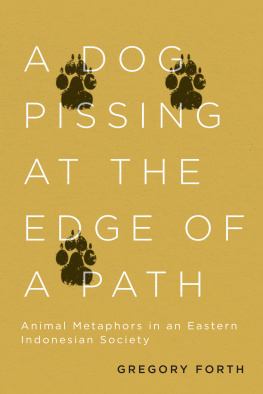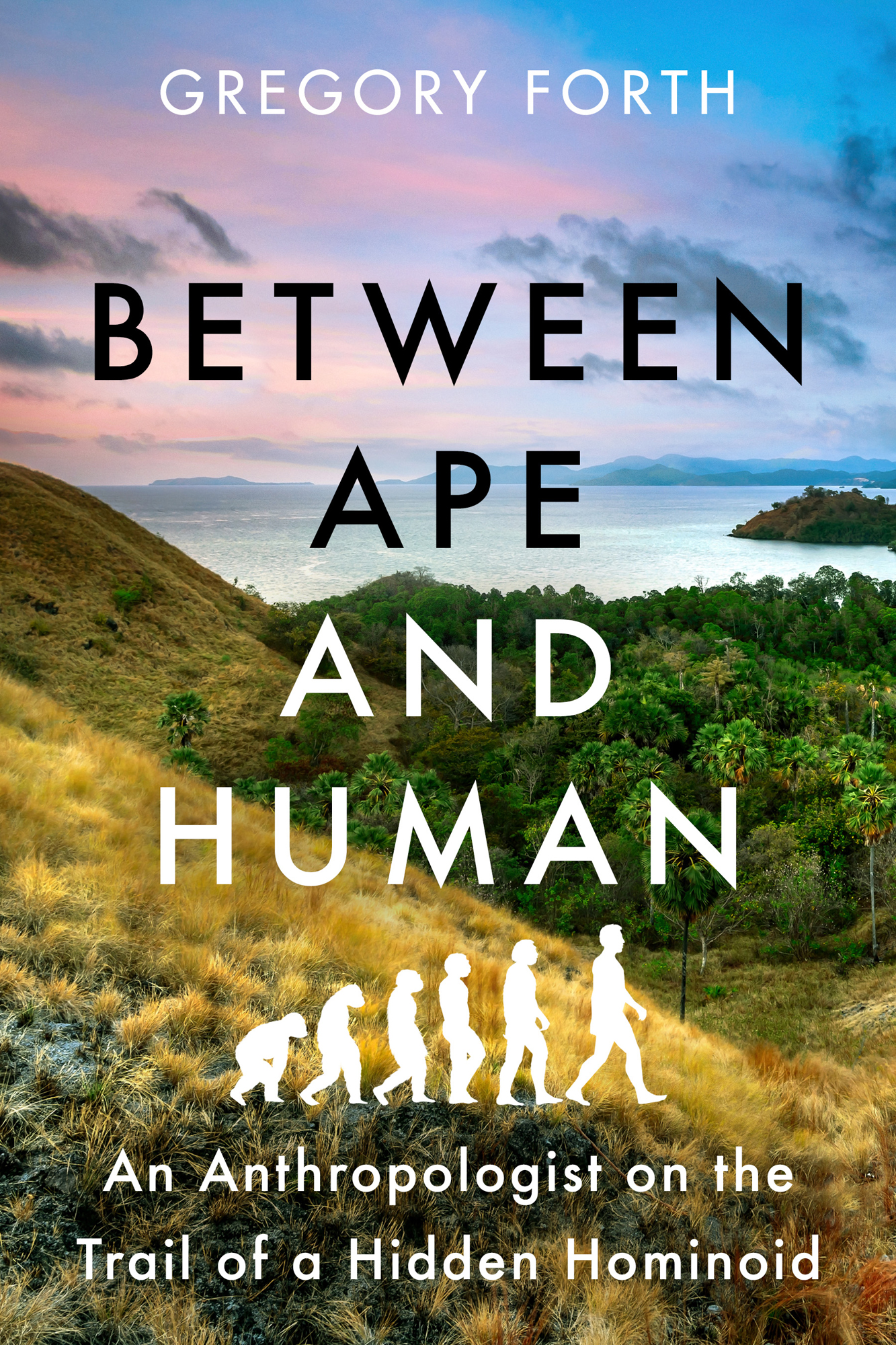CONTENTS
Guide
Gregory Forth
Between Ape and Human
An Anthropologist on the Trail of a Hidden Hominoid
To the memory of my father, Leslie William Forth (19252021), who passed away after a long, productive, and generous life, and just a few weeks after this book was accepted for publication.
1 APE-MEN OF FLORES ISLAND
I n the far reaches of the Indonesian archipelago lies Flores (8.6574 S, 121.0794 E), a long narrow island of high mountains, precipitous cliffs, and deep ravines. The climate is tropical. Rain is seasonal and is heavy when rain-bearing west monsoon winds blow from October to Aprildefinitely the wet season in this part of the archipelago. In southern regions, though, and in the high mountain forests that cover much of the islands interior, rain can fall in any month. By contrast, Floress north coast, including a narrow coastal plain that runs along much of the island, enjoys far less rain, is less fertile, and reveals a semiarid landscape. Thus it is only certain parts of the island that live up to the name Flores, Flowers, which early Portuguese navigators took from Tanjung Bunga, Cape of Flowers, a name given by their Malay-speaking pilots to the islands eastern and, ironically, not particularly verdant extremity. (Why precisely they called the cape flowery remains a mystery.)
Like the rest of Indonesia, Flores belongs to the famous ring of fire, the great chain of volcanoes that encircles the Pacific Ocean. Even by Indonesian standards, Flores is highly volcanicanother factor conducive to plant fertility. Yet contrary to what volcanoes, monsoon rains, and tropical forests might suggest, native animal life is neither rich nor varied. Because of the islands location well east of Wallaces Linenamed after Alfred Wallace, the renowned naturalist and, with Darwin, cofounder of evolutionary theoryFlores falls within the Australasian zoogeographical region and is poor in mammal species. (Australia is obviously located in the same region, but Flores lacks the marsupials found on the great island continent.) Native mammals include mostly rats and bats. So most of the larger mammals now found on the island, including both wild animals (monkeys, exclusively Macaca fascicularis, or long-tailed macaques; porcupines; civets; and deer) and domestic species (pigs, water buffalo, goats, horses, dogs, and cats) were brought to Flores by human immigrants from the north or westthe earliest presumably coming in outrigger canoes.
While not short of birds and reptiles (including crocodiles and at least four species of venomous snakes), Flores therefore lacksindeed has never hadsuch large animals as the tigers, leopards, bears, elephants, and rhinoceroses characteristic of larger western Indonesian islands and mainland Southeast Asia. For what comes later its important to mention that Flores has never had apes eitherthose large, tailless primates represented by orangutans on Borneo and Sumatra and by gibbons on Borneo, Sumatra, Java, and Bali.
But what Flores lacks in animal variety it certainly makes up for in the remarkable character of several native species. Among these is the worlds largest rat, the aptly named Flores giant rat (Papagomys armandvillei), a ferocious, mostly tree-dwelling beast that, including the tail, grows up to 80 centimeters long (or over 2.5 feet). The rat is an island endemicmeaning it is found only on Flores (see ). And almost endemic is the worlds largest lizard, the Komodo dragon (Varanus komodoensis), a voracious carnivore and ambush predator with a venomous bite that can attain a length of more than 3 meters (nearly 10 feet). Other than Flores, the dragon occurs only on its namesake island of Komodo and other small islands, all immediately west of Flores.
Looking back into prehistory, I could also mention the evolution on Flores of now-extinct pygmy stegodons, elephant-like creatures no larger than a cow. But the subject of this book is an even more remarkable and even less expected animalor perhaps two animals of very similar kinds.
One is an extremely small-bodied fossil human named Homo floresiensis (Flores human). The species is known only from remains found in 2003 at Liang Bua (Bua Cave) in western Flores. Standing little more than a meter (3 feet, 3 inches) tallthe height of a two- to three-year-old Western childthe tiny species quickly became nicknamed the hobbit, after the Tolkien characters. In view of this hobbits skeletal featuresdescribed as archaic by paleontologists and, in several respects, comparable to those of Australopithecines (prehistoric southern apes that lived from two to four million years ago) or even chimpanzeesanother surprise was the species extraordinarily recent dates. Initially the last known date for floresiensis was estimated at just twelve thousand years ago, or eighteen thousand years ago for the type specimen, or holotype, that is, the most complete of several skeletons found at the same site (see ). More recently the date was revised to fifty to sixty thousand years ago, but in geological terms this is still remarkably young. The discovery caused a sensation in the scientific world and captured the attention of the general public as well. And in spite of initial controversy, research conducted after the discovery has confirmed that Homo floresiensis is a new species.
The other humanlike creature alluded to above, which for convenience I call an ape-man, has yet to be scientifically identified. But one of several ethnolinguistically distinct groups that populate Flores Island, a people called Lio, claims these creatures are alive (if not well) in remote sections of their mountainous territory. In their own language, the Lio (pronounced Lee-oh) name these ape-men lai hoa. They describe them as smallin fact about the same size as floresiensisas walking upright on two legs, and as hairy-bodied or, at any rate, hairier than themselves. Lio also characterize the ape-men as culturelesslacking tools, weapons, clothing, and even fire. Floresiensis, too, might have been hairy, though we shall never know. And while the question has yet to be settled, theres no firm evidence for the fossil species having used either fire or stone tools.
Although often described as taller or larger-bodied, humanlike creatures like these ape-men have been reported elsewhere on Flores Island, in Indonesia, and in other parts of the world. But adding to the intrigue of the lai hoa is the fact thatunlike similar beings reported from other parts of Flores, which local people consider extinctthese ape-men are claimed to have survived to the present. In addition, individual Lio offer credible accounts of specimens they have seen, including eyewitness encounters dating from the 1960s to as recently as 2017 or 2018. And all this on an island that, for thousands of years, was home to an archaic species of Homo (the genus that includes Homo sapiens), which according to the reconstructions of paleoanthropologistsanthropologists who study prehistoric humansseem to have differed hardly at all from the Lio ape-man.
So far as we know with any certainty, modern humans (or what paleoanthropologists more exactly call anatomically modern humans) first reached Flores around eleven thousand years ago, at the end of the Pleistocene (or Ice Age). By contrast Homo floresiensis had been living on the island since around a hundred thousand years ago, and the species ancestors may have arrived much earlier. Because dates are available only from a single site, when floresiensis disappearedor even if it disappearedis not known.









